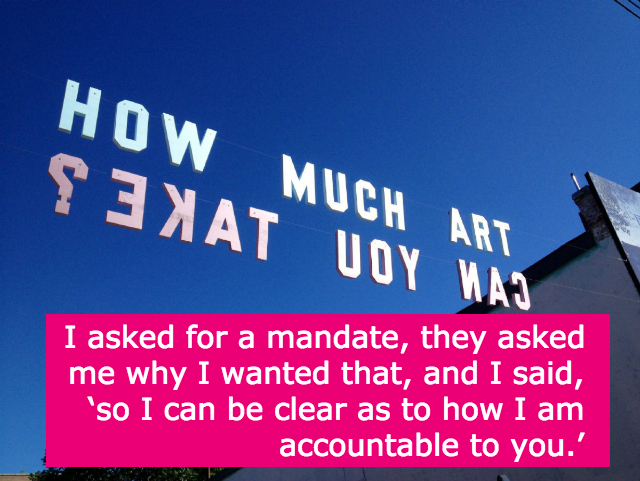
Interior of MOCCA’s new place at 158 Sterling Road. Credit: Museum of Contemporary Canadian Art/Art Toronto
If the Museum of Contemporary Canadian Art (MoCCA) were a book, its cover would be looking pretty good right now. The 17 year old institution dedicated to showcasing contemporary artists is in the midst of moving into Toronto’s historic Tower Automotive Building. Expected to occupy 25,000 square feet of the industrial heritage building now being restored by developer Castlepoint Numa, MoCCA’s new permanent home will be the so-called anchor tenant of a new mixed-used community in the Lower Junction neighbourhood. On top of that, the organization hired its first-ever CEO Chantal Pontbriand to bring an international outlook and shake things up. With so many hurdles cleared, MoCCA appears on the verge of becoming one of Toronto’s few international institutional players.
But judging a book by its cover has its risks. The institution still carries the baggage of its transitional period, which was marked by poorly-handled organizational restructuring. And with no news regarding its future programming — not to mention questions about exactly how long-time Artistic Director and Curator David Liss will share creative visioning with a new leader — today’s AGO lecture by Pontbriand seems a particularly hot ticket. Will this confusion finally be cleared up?
The short answer is no. In a phone call with AFC, the Montrealer told us she would be speaking about her first impressions of Toronto, and will likely focus on her curation of the Demo-Graphics biennale, slated for 2017. What most certainly won’t be discussed are the persistent management issues MoCCA has been struggling with, and how she’ll involve herself in addressing these issues. It’s too early for game-changing moves.
Liss candidly admits in an email interview with AFC that in the past three to four years, he’s “spent more time in the Toronto property market than I have in galleries and artists’ studios.” In 2012, when MoCCA was informed by its new landlord, UrbanCorp, that it would need to vacate its Queen and Shaw home by March 2014, Liss actively cast about for new digs. In response to UrbanCorp’s condo development, the non-profit arms-length City of Toronto agency became an independent charity, MoCCA Corp., and managed to extend its lease to August 2015.
With Liss focusing on capital developments, the organization’s administrative structure suffered greatly. Much of this was expected and the staff adapted, because MoCCA offered professional development opportunities. According to Brett Despotovich, MoCCA’s former head of gallery operations and visitor services, “it was kind of like you’re in this little gang against all odds. You were given this impossible task in putting this event on or whatever it is. Everybody was up for it out of respect to the nature of the institution and out of respect to each other.”
A ROCKY TRANSITION
Most agree that when managing director Yves Theoret moved on in early 2014 to become the National Gallery of Canada’s Director of Exhibitions and Outreach, a key communication conduit between gallery and office staff went missing. HR and personnel support fell to the wayside. (In an email response to AFC’s interview request, Theoret, now the Head of Curatorial Affairs at the Montreal Museum of Fine Arts, stated “unfortunately, I do not have any insights into MoCCA’s period of transition. The only knowledge I have of the situation is through what has been reported in the media.”)
Julia Dow was brought on to close that gap in August 2014 as general manager. According to multiple sources, her tenure didn’t go well. Despite initiating the successful Mini MoCCA educational programme, her lack of gallery experience and knowledge of contemporary art almost immediately became an issue: Su-Ying Lee, MoCCA’s former assistant curator, recalls having difficulty explaining why some initiatives would not work. In one instance Dow requested artists to create an editioned art work only a few weeks before an exhibition opened, noting she was under “a great deal of pressure” to spearhead monetizing initiatives. Typically museums work a year ahead.
Consistently, staff members found their expertise was either under-utilized or not used at all. Dow was gone by January 2015. When contacted for an interview request, Dow stated that she and the museum parted on agreed-upon terms that did not allow her to speak to the press.
But Dow was not the only one responsible for management issues that affected programming. Liss, for example, tasked Lee with managing shipping and exhibition coordination, when media coverage celebrating her appointment had conveyed she’d be an “active contributor” to the museum’s programming. While the institution continued its successful partnership programming with the National Gallery of Canada, its curatorial vision suffered. It’s also telling that during her time with MoCCA, Lee only curated the fall 2014 group exhibition, TBD.
THE LONG #952BYEBYE
By February 2015, “it became clear that the situation on Sterling was going to work out” with Castlepoint Nuvo developers says Liss. But some staff weren’t given direct information regarding the property search, and were excluded from programming and communication meetings.
Soon enough, the staff restructuring began. In April, Despotovitch, who had worked at the museum for six years, was informed his employment would end in August. José Talavera, who had been a gallery attendant with MoCCA when it was still the Art Gallery of North York in 1993, was also let go. Despotovitch was given early notice so the organization would not have to pay him severance.
John Kennedy, who began as an installer with MoCCA in 2007 before being promoted to head of the department a year later, didn’t even recall a conversation about his termination happening with Liss. Two other employees left within the last year. Both declined to be interviewed for this story. (As expected, MoCCA also cut roughly 15 freelance gallery attendants and installers normally employed during the exhibition season.)
The biggest blow to programming came in June with the formation of a programming committee. The committee included three members from the board: artist Joanne Tod, the Gladstone Hotel’s “Chief Alchemist” Christina Zeidler and art critic Randy Gladman. (Despite repeated attempts to get in contact with the board, AFC’s interview requests went unanswered.) Lee, then assistant curator for MoCCA, wasn’t told who spearheaded the initiative, and even though she was tasked to research and develop all of MoCCA’s 2016 programming, was given no directive. “When I asked the committee for some clarity on why the committee was formed, I did not get it. I asked for a mandate, they asked me why I wanted that, and I said, ‘so I can be clear as to how I am accountable to you.’ That was not really given to me.”
She developed a year-long thematic focus around migration slated to take place in the city’s public spaces.The program was intended to help MoCCA reach beyond its then-current 952 Queen Street West location. When she presented her proposal to the programming committee, she was informed that the committee wanted “more spectacle”.
When AFC asked Liss about the board’s decision to form a programming committee, he took full responsibility for the initiative. According to Liss, there were many different visions for MoCCA amongst the board, and the committee was created as a means of forming consensus. There was a split in determining whether MoCCA should seek a temporary exhibition venue, partner with other venues on “pop-up” projects, or forgo the programming all together. “So within this context, in June I formed a programming committee that consisted of three people from the Board: Joanne Tod, Christina Zeidler and Randy Gladman, with the intention of discussing and considering the various opinions, options, strategies and opportunities for interim programming.”
Lee’s two-year tenure with MoCCA ended in August. Even though she was offered permanent employment, her attempts to renegotiate were rebuffed—”the offers of permanent employment were pulled and replaced with a one year contract under the same conditions.”
LEADERSHIP SHIFTING
With Lee gone, and no programming to speak of for 2016, a hole needed filling. In October, it was announced that Chantal Pontbriand was hired as MoCCA’s new CEO.
Confusion surrounded her appointment. Pontbriand appeared to have two conflicting full-time positions; the job she had when she was hired—Artistic Director and Curator of the Demo-Graphics biennial’s first edition—and the job she’d be taking on, CEO of MoCCA. If Liss had been challenged in having to take on two roles within the organization, would Pontbriand’s numerous obligations also create issues? Further, the duties Pontbriand would take on seemed murky at best.
We reached out to Pontbriand for clarification, who told AFC, “it’s the story of my life to sort of do two major things simultaneously,” she says with a laugh, referencing her time in Montreal overseeing the influential art journal Parachute and the Festival international de nouvelle danse (FIND). “And I am very comfortable with that. For me, it’s not a problem. I am sure for many people it would be. I have a training, so at this point, it’s quite fine.”
On the juggling of Demo-Graphics and MoCCA, Pontbriand explains that while she’s handling MoCCA’s capital fundraising campaign, that’s not the case for Demo-Graphics: it is typical biennale curatorial structure, in that she’s the director working with a team that includes advisor Sarat Maharaj (part of Okwui Enwezor’s Documenta XI curatorial team), executive director Asma Arshad Mahmood and co-director Yvonne Singer.
Pontbriand told AFC that soon after she joined MoCCA in early November, she presented a five-year plan at a board meeting because they didn’t have one. When pressed on whether she was brought in to define MoCCA’s creative vision, she immediately responded, “absolutely. That was what I was hired to do.”
Later we sought clarification from Liss who, in an earlier email, had described himself as holding the same responsibilities. Would he simply be executing Pontbriand’s plan? “As CEO she’ll certainly be playing a role in program development as well as every other aspect of the organization.” he responded. “She was hired because the Board felt that her institutional vision was compatible with ours. At this point, we’re developing programming together. She’ll be working on some of her ideas and I’m working on mine and we also have plans to produce shows together. But I wouldn’t characterize the situation as me executing her plans. And it’s still pretty early.”
But some art world watchers think it is Pontbriand who’s now in charge. Murray Whyte’s profile on Pontbriand for Toronto Star may be the first piece of MoCCA press without any mention of Liss. “Everyone is really respectful that David’s focus had to be on finding a new space,” the newspaper’s visual arts critic explains to AFC. “But it seems now there is definitely a lot of work being done to resolve the programming issue.”
“It’s very obvious to anyone looking that Chantal is here to be in charge and reinvent MoCCA as she sees fit … I don’t think there is any questioning of that. They have chosen her to be the public face of the new MoCCA.”





Comments on this entry are closed.
{ 1 trackback }